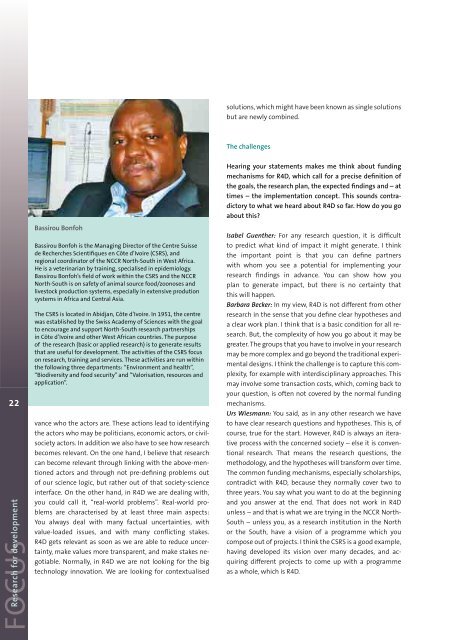NORTH-SOUTH CENTRE - ETH - North-South Centre North-South ...
NORTH-SOUTH CENTRE - ETH - North-South Centre North-South ...
NORTH-SOUTH CENTRE - ETH - North-South Centre North-South ...
You also want an ePaper? Increase the reach of your titles
YUMPU automatically turns print PDFs into web optimized ePapers that Google loves.
solutions, which might have been known as single solutions<br />
but are newly combined.<br />
The challenges<br />
22<br />
FOCUS<br />
Research for development<br />
Bassirou Bonfoh<br />
Bassirou Bonfoh is the Managing Director of the <strong>Centre</strong> Suisse<br />
de Recherches Scientifiques en Côte d’Ivoire (CSRS), and<br />
regional coordinator of the NCCR <strong>North</strong>-<strong>South</strong> in West Africa.<br />
He is a veterinarian by training, specialised in epidemiology.<br />
Bassirou Bonfoh’s field of work within the CSRS and the NCCR<br />
<strong>North</strong>-<strong>South</strong> is on safety of animal source food/zoonoses and<br />
livestock production systems, especially in extensive prodution<br />
systems in Africa and Central Asia.<br />
The CSRS is located in Abidjan, Côte d’Ivoire. In 1951, the centre<br />
was established by the Swiss Academy of Sciences with the goal<br />
to encourage and support <strong>North</strong>-<strong>South</strong> research partnerships<br />
in Côte d’Ivoire and other West African countries. The purpose<br />
of the research (basic or applied research) is to generate results<br />
that are useful for development. The activities of the CSRS focus<br />
on research, training and services. These activities are run within<br />
the following three departments: “Environment and health”,<br />
“Biodiversity and food security” and “Valorisation, resources and<br />
application”.<br />
vance who the actors are. These actions lead to identifying<br />
the actors who may be politicians, economic actors, or civilsociety<br />
actors. In addition we also have to see how research<br />
becomes relevant. On the one hand, I believe that research<br />
can become relevant through linking with the above-mentioned<br />
actors and through not pre-defining problems out<br />
of our science logic, but rather out of that society-science<br />
interface. On the other hand, in R4D we are dealing with,<br />
you could call it, “real-world problems”. Real-world problems<br />
are characterised by at least three main aspects:<br />
You always deal with many factual uncertainties, with<br />
value-loaded issues, and with many conflicting stakes.<br />
R4D gets relevant as soon as we are able to reduce uncertainty,<br />
make values more transparent, and make stakes negotiable.<br />
Normally, in R4D we are not looking for the big<br />
technology innovation. We are looking for contextualised<br />
Hearing your statements makes me think about funding<br />
mechanisms for R4D, which call for a precise definition of<br />
the goals, the research plan, the expected findings and – at<br />
times – the implementation concept. This sounds contradictory<br />
to what we heard about R4D so far. How do you go<br />
about this?<br />
Isabel Guenther: For any research question, it is difficult<br />
to predict what kind of impact it might generate. I think<br />
the important point is that you can define partners<br />
with whom you see a potential for implementing your<br />
research findings in advance. You can show how you<br />
plan to generate impact, but there is no certainty that<br />
this will happen.<br />
Barbara Becker: In my view, R4D is not different from other<br />
research in the sense that you define clear hypotheses and<br />
a clear work plan. I think that is a basic condition for all research.<br />
But, the complexity of how you go about it may be<br />
greater. The groups that you have to involve in your research<br />
may be more complex and go beyond the traditional experimental<br />
designs. I think the challenge is to capture this complexity,<br />
for example with interdisciplinary approaches. This<br />
may involve some transaction costs, which, coming back to<br />
your question, is often not covered by the normal funding<br />
mechanisms.<br />
Urs Wiesmann: You said, as in any other research we have<br />
to have clear research questions and hypotheses. This is, of<br />
course, true for the start. However, R4D is always an iterative<br />
process with the concerned society – else it is conventional<br />
research. That means the research questions, the<br />
methodology, and the hypotheses will transform over time.<br />
The common funding mechanisms, especially scholarships,<br />
contradict with R4D, because they normally cover two to<br />
three years. You say what you want to do at the beginning<br />
and you answer at the end. That does not work in R4D<br />
unless – and that is what we are trying in the NCCR <strong>North</strong>-<br />
<strong>South</strong> – unless you, as a research institution in the <strong>North</strong><br />
or the <strong>South</strong>, have a vision of a programme which you<br />
compose out of projects. I think the CSRS is a good example,<br />
having developed its vision over many decades, and acquiring<br />
different projects to come up with a programme<br />
as a whole, which is R4D.
















